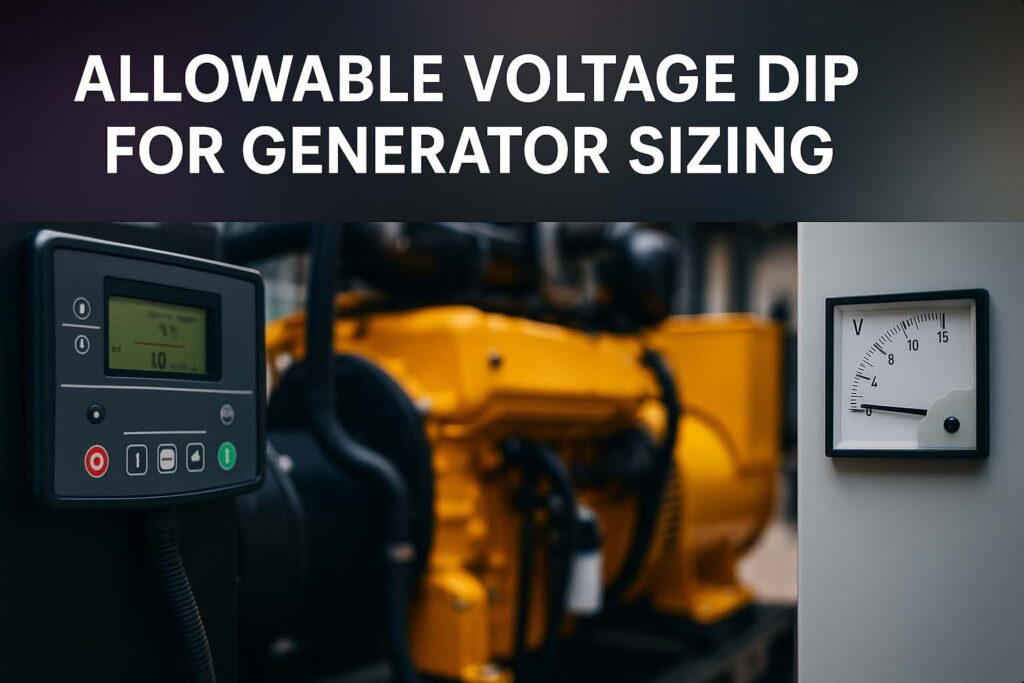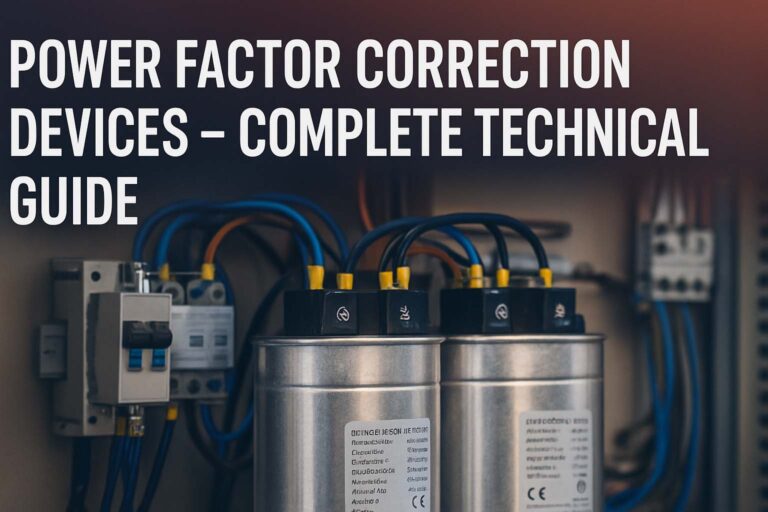Allowable Voltage Dip for Generator Sizing
When sizing a generator, one of the most important technical considerations is the allowable voltage dip for generator sizing. This parameter affects not only the generator’s size but also the performance of equipment it powers. Understanding this concept is essential for engineers, technicians, and facility managers.
A voltage dip is a temporary drop in voltage. It usually occurs when a load is applied to the generator. The drop may only last for a few milliseconds, but it can have a serious impact on sensitive equipment.
Generators do not deliver full voltage instantly. When starting motors or large loads, there is a surge in demand. This demand causes a temporary voltage drop. If this dip exceeds allowable limits, equipment may fail to start or could be damaged.

The allowable voltage dip is the maximum drop in voltage that connected equipment can tolerate without malfunctioning. For most applications, the common range is between 10% and 30%. However, the specific allowable dip depends on the type of load and criticality.
Generators are usually oversized to maintain voltage within this acceptable dip range during load steps. The lower the voltage dip limit, the larger the generator needed.
Why Allowable Voltage Dip for Generator Sizing Matters
Incorrect generator sizing can result in operational problems. When loads are turned on, especially inductive ones like motors or transformers, they draw high inrush currents. These inrushes cause voltage to sag temporarily.
If the allowable voltage dip for generator sizing is not properly considered, this sag may exceed acceptable thresholds. The result may be:
- Lights flickering or turning off
- Relays dropping out
- Motor contactors chattering
- UPS or inverter systems failing
Power systems must maintain voltage stability, especially for sensitive industrial processes or data centers. Choosing a generator that meets voltage dip criteria ensures safe startup of all loads and avoids costly downtime.
Generator Sizing Based on Allowable Voltage Dip for Generator Sizing
To size a generator correctly, the voltage dip allowed must be matched to the inrush current characteristics of the connected load. Generator manufacturers provide data for voltage dip performance under various load steps.
Let’s consider an example. If a motor requires 500 A of starting current and the allowable voltage dip is 15%, we must size the generator to handle this current surge without voltage dropping below that 15%.
Most engineers use generator sizing software. These tools simulate load steps and predict voltage dips. But understanding the basics of allowable voltage dip for generator sizing helps validate software outputs.
Learn more about how to design LV and MV systems
Table: Voltage Dip Tolerance for Common Equipment
| Equipment Type | Typical Allowable Voltage Dip | Notes |
|---|---|---|
| Incandescent Lighting | 10% – 20% | Slight dips may be visually noticeable |
| Motors (Across-the-line start) | 15% – 30% | Depends on motor size and inertia |
| PLCs and Controls | 5% – 10% | Highly sensitive to voltage changes |
| UPS Input | 10% – 15% | May transfer to battery if exceeded |
| Medical Equipment | 5% – 8% | Very strict power quality requirements |
This table is a guideline. Final decisions must be based on manufacturer specs and local standards.
Calculating Generator Size with Allowable Voltage Dip for Generator Sizing
To perform the sizing, the engineer must calculate:
- Load current or kVA
- Starting current of loads
- Acceptable voltage dip (e.g., 15%)
- Generator short circuit ratio (SCR) and sub-transient reactance (X″d)
The voltage dip caused by starting current can be estimated using the following formula:

To calculate the required generator size based on allowable dip:

Where:
- X″d = Sub-transient reactance of the generator (in per unit or %)
- Starting kVA = Load starting requirement
- Rated Generator kVA = The minimum generator capacity to keep dip within limits
These formulas help give a starting point. For accurate design, refer to detailed generator data and simulation tools.
Practical Considerations in Allowable Voltage Dip for Generator Sizing
In real installations, it’s not just about theoretical calculations. Practical factors must be considered. The generator must start loads reliably even during worst-case conditions.
Motor starting is a key factor. A large motor may need six to eight times its full-load current for just a few seconds. If the system includes multiple motors starting at once, the effect is compounded.
To reduce generator size, engineers may consider:
- Using soft starters
- Staggering motor starts
- Installing variable frequency drives (VFDs)
These strategies limit the inrush current, reducing the voltage dip and the generator size needed.
Allowable Voltage Dip for Generator Sizing in Critical Facilities
Critical facilities like hospitals, data centers, and industrial plants must keep power quality stable at all times. Even small dips can trigger alarms or process shutdowns.
In these cases, the allowable voltage dip for generator sizing must be tightly controlled. Engineers often choose dip limits as low as 5% or 7%, even if that means using a much larger generator.
This trade-off ensures reliability and reduces the chance of load shedding during transitions.
How Generator Reactance Affects Voltage Dip
The generator’s ability to maintain voltage during a load application depends on its internal impedance. Specifically, the sub-transient reactance (X″d) plays a big role. The higher the X″d, the greater the voltage dip.
Large generators typically have lower reactance values, making them more resilient to dips. Small portable units, however, may have high X″d and suffer large voltage swings.
This is why a high short circuit ratio (SCR) is desirable in generator design. It means the generator has better voltage regulation characteristics.
Voltage Regulator Role in Managing Dip
The Automatic Voltage Regulator (AVR) in the generator helps reduce the severity and duration of voltage dips. But the AVR reacts after the dip begins—it cannot prevent it entirely.
If the load causes a massive inrush, the AVR will boost excitation to recover voltage. However, its response is not instant. For this reason, generator sizing must assume that some dip will occur before AVR action stabilizes the output.
International Standards on Allowable Voltage Dip for Generator Sizing
Several standards address allowable voltage dips for generators:
- IEEE Std 141: Recommends not exceeding a 15% dip during motor starting
- IEC 60034-1: Suggests maximum transient voltage dips during startup
- NFPA 110: Sets minimum voltage stability requirements for emergency power systems
These standards are good reference points. But always confirm with local codes and client-specific requirements.
Conclusion on Allowable Voltage Dip for Generator Sizing
The allowable voltage dip for generator sizing is not just a technical formality. It is a crucial factor that determines whether your generator will perform as expected under load.
Underestimating voltage dip requirements leads to undersized generators, equipment failures, and power quality issues. Overestimating can result in excessive capital cost and fuel consumption.
A balanced approach is essential. Engineers must study the load characteristics, equipment sensitivity, and startup behavior. With proper analysis, it’s possible to select a generator that keeps voltage within acceptable limits, ensuring reliability and efficiency.
Always remember, the allowable dip is not a fixed value. It must be tailored to the application, load types, and power quality expectations. In mission-critical setups, tighter control of voltage dip justifies the higher cost of a larger generator.
Follow Us on Social:
Subscribe our Newsletter on Electrical Insights for latest updates from Electrical Engineering Hub
#VoltageDip, #GeneratorSizing, #ElectricalEngineering, #PowerQuality, #VoltageRegulation, #StandbyGenerator, #MotorStarting, #VoltageDropLimits, #GeneratorDesign, #GeneratorSelection, #PowerSystemDesign, #EngineeringStandards, #VoltageStability, #GeneratorPerformance, #LoadAnalysis




